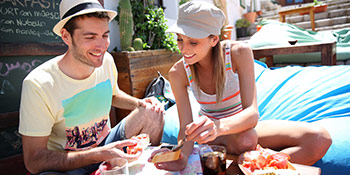Phone: + 39 0541 798670 E-mail: office@bistravel.it
Apulia, Italy
Apulia, ITALIAN REGIONS-
 View Largebtravel_apulia_1
View Largebtravel_apulia_1 -
 View Largebtravel_apulia_2
View Largebtravel_apulia_2 -
 View Largebtravel_apulia_3
View Largebtravel_apulia_3 -
 View Largebtravel_apulia_4
View Largebtravel_apulia_4 -
 View Largebtravel_apulia_5
View Largebtravel_apulia_5 -
 View Largebtravel_apulia_6
View Largebtravel_apulia_6
Also known as “Le Puglie” in the plural form, this region contains, in fact, many souls. The “heel of Italy’s boot,” Apulia is a charming region that can be visited all year round and is suspended among nature, history, tradition, tastes and spirituality.
Apulia, the spur of the Italian Boot, is an enchanting region that spreads lengthwise along the sea – marvelous beaches that will delight every traveler, from the sandy Torre dell’Orso and Porto Cesario, to the rocky, boulder-encrusted Riviera of Otranto and Santa Maria di Leuca. At Santa Maria di Leuca the calm and crystalline waters of the Ionian Sea mix with those of the intense and azure Adriatic. Sea lovers have multiple options in Apulia, from Gallipoli, the “Gem of Salento,” to Gargano, “Italy’s Buttress,” which protrudes out into the clear sea, where one finds the the beautiful Tremiti Islands.
Nature is the protagonist again in the Murgia National Park, and in Gargano’s wild Umbra forest, its salt pans and lakes. Visit the marine reserve of Torre Guaceto and the deep ravines of Laterza and wide dolines (depressions in the terrain) of Altamura characterize the hinterland of the region with their charming landscapes. For those who want to travel through history, Apulia offers a wide range of places that testify to the ancient origins of this land: from prehistory to Magna Graecia, from the Imperial Age to the Renaissance and the Baroque splendor of Lecce and of Salento. The trulli, for example those of Valle d’Itria, offer an evocative testimony to the rural past of the region. Meanwhile, numerous castles dot the coasts of the southern coast, hinting at an era when both perils and commerce landed on these shores.
For who is interested in tradition and folk music, should attend the numerous festivals and fish sagre that in summertime run throughout the region.
The provinces of Apulia are: Bari (regional capital), Brindisi, Foggia, Lecce and Taranto, Barletta-Andria-Trani. .

Apulia is a region that can satisfy any taste and interest, from its ancient history to the Medieval and Baroque epochs, from its castles that line the coast to the tiny, artistic borgoes where artisanl masterpieces come to life.
The most devout – but not only – should not miss a trip to San Giovanni Rotondo (Foggia), to visit the places of St. Pio of Pietrelcina, the monastery of Capuchin friars of Santa Maria delle Grazie, where Padre Pio died in 1968, and the new church designed by great architect Renzo Piano, open since 2004.
For a full immersion in history and tradition, Alberobello is a must. The town of the trulli – ancient and peculiar stone houses with a conical roof, built without mortar- is so unique that it has been inscribed on the UNESCO World Heritage List.
Besides its trulli, Apulia hosts another UNESCO site in the town of Andria, Castel del Monte, an unrivalled masterpiece of Medieval architecture commissioned by Frederick II of Hohenstaufen in the 13th Century. It is interesting to know that the number 8 is the motif of the castle: the sides of the castle are eight, the rooms of the ground floor and the first floor are eight, and the grand octagonal-planned towers are eight-sided as well.
San Domino, San Nicola, Capraia, Cretaccio and Pianosa are the five islands of the Tremiti Archipelago, a tiny paradise where history and nature merge perfectly and offer a wonderful landscape to explore.

The two seas of Apulia are ideal for an athletic vacation in nature.
Opportunities abound for those who love the excitement of exploring the charming and mysterious environment of the sea. The crystal-clear waters of the Tremiti Islands paint an incredible seascape, animated by coves, caves and deep seabeds, and populated by lush vegetation and many species of fish. Santa Maria di Leuca, between the Ionian Sea and the Adriatic Sea, is another unmissable destination. In some tracts, the seabeds are up to 90 meters deep and the life forms that colonize this part of the sea create a fascinating interplay of colors. Those who choose to have fun staying above water can windsurf or kitesurf in several different spots (and not only during the summer).
Still, Apulia is not just about its sea.
If you want to discover the wonders of nature in this territory, or get to know its history and traditions via a different mode of transport, a bike tour is just perfect. It is not necessary to be a skilled cyclist to set out on a journey on two wheels; it only takes the desire to enjoy a different experience. There are many itineraries to choose from: nature, pedalling along the paths of the Gargano Park or the Murgia National Park; history, discovering the vestiges that testify to the many ages of this land; or countryside, sorjourning into the hinterland to seek out lifestyles far from the frenzy of big cities.
Finally, many festivals, fairs and historical celebrations are held all year-round in every part of Apulia: the Carnival of Putignano, the San Nicola Festival in Bari and the Disfida di Barletta (Challenge of Barletta) are the most famous. And no one should miss the Night of the Taranta at Melpignano, the festival of the pizzica and tarantelle dances that every August delights visitors from all over Europe, enticing them to sing and dance to the sounds of the tambourine under the light of the moon.

Apulian cuisine has always been defined as “poor” for its simple ingredients; yet, it satisfies any palate. Its basic elements are three: durum wheat, vegetables and olive oil, combined with meat and fish to create original dishes with genuine and unmistakable flavors.
The hallmark of regional cooking is homemade pasta made with durum wheat or a mix of durum and soft wheat: from recchietelle (also called orecchiette) that, in its many versions, is a symbol of the region, to the famous strascinati, that once were the main course for the poorest families and are now ordered and served in the best restaurants. Then, mignuicchie, fenescecchie, troccoli, sagne ‘ncannuate, cicatadde and other original types of pasta are still made according to historic traditions.
Particularly, the combination between pasta and vegetables is unexpectedly surprising, like strascinati with cabbage and fried bacon or spaghetti with string beans, tomatoes and cacioricotta cheese. In fact, Apulia is one large, aromatic vegetable garden that boasts unparalleled flavors and colors. When combined with homemade pasta, fresh fish, or even good meat, they leave the palate with unforgettable sensations.
This region, with its 800 km (497 mi) of coast and two sea
s, offers a great variety of fish specialties for those who know how to appreciate it: raw, marinated, poached in delicious fish soups and even with cheese.
Those who have a sweet tooth, rather, will find lots of temptations with dried fruit, honey, mulled wine, candied fruit and chocolate. (Be sure to taste the Christmas sweets as well, if you should be so lucky.)
Among the quality products, awarded with the labels DOP (Denomination of Protected Origin) or RGI (Regional Geographical Indication), are Altamura bread, famous for its crispness; sweet and juicy Clementine Tangerines from the Gulf of Taranto; the Bella della Daunia, a type of olive cultivated in the area of Foggia since 1400, and the famous wines and extra-virgin olive oils, all with their very own characteristics according to production area.

NEWSLETTER